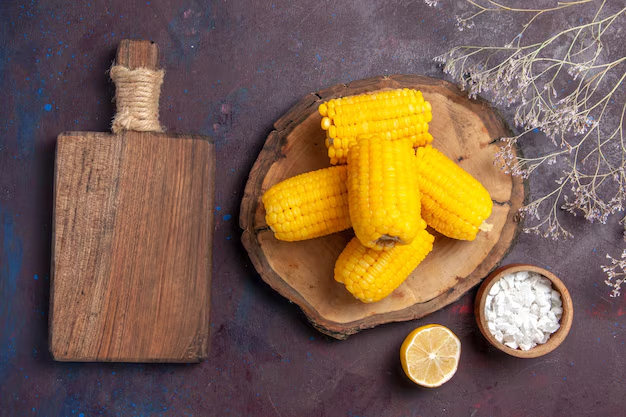Keeping Corn Fresh: How Long Can It Last in the Refrigerator? 🌽
Corn on the cob is a popular summer favorite, often enjoyed grilled, boiled, or baked at barbecues and family gatherings. But what happens when your eyes were bigger than your stomach and you have leftovers? You're left pondering the question: How long does corn last in the refrigerator? Understanding the shelf life of corn and the best storage methods is crucial to maximize freshness and minimize food waste. Let’s delve into the ins and outs of storing corn, whether on the cob or off, to keep it tasting sweet and crisp.
How Long Does Fresh Corn Last?
Corn on the Cob
Fresh corn on the cob, ideally stored in the refrigerator shortly after picking or purchasing, should be consumed within three to five days. Fresh corn is best when eaten soon after harvest, as it quickly loses sweetness and texture. Refrigerating corn slows down this process by preserving its natural sugars.
Shucked Corn
If you’ve already shucked the corn, removing it from the husk and silk, it may have a slightly shorter lifespan. Generally, shucked corn lasts about two to three days in the refrigerator. Without the protective husk, the kernels are more exposed to air and moisture, which can hasten their decline.
Optimal Storage Practices for Corn 🌾
With Husk
To maximize the shelf life of your corn, keep the husk intact. The husk, along with the silk, provides a natural protective barrier. Here’s how to store corn with its husk:
- Refrigerate Promptly: Place corn in the refrigerator as soon as possible after harvesting or purchasing.
- Avoid Plastic Bags: If possible, avoid sealing corn tightly in plastic, as this can trap moisture and lead to mold.
- Moisten the Husk: Lightly moisten the husk before refrigeration to help maintain kernel moisture.
Without Husk
If you’ve already removed the husk, follow these steps to keep your corn fresh:
- Air-Tight Containers: Store shucked kernels or cobs in an air-tight container or zip-lock bag.
- Paper Towels: Place a dry paper towel in the container or bag to absorb excess moisture and reduce the chance of mold.
Indicators of Spoiled Corn 🌽
While refrigeration helps extend freshness, identifying signs of spoilage ensures safety and quality. Be on the lookout for:
- Mold: Visible mold growth on kernels indicates it’s time to discard the corn.
- Slimy Texture: A slimy surface on kernels or cobs suggests spoilage.
- Unpleasant Odor: Any off or sour smell is a sign that the corn has gone bad.
When in doubt, trust your senses. It’s better to err on the side of caution.
More Ways to Extend Corn’s Lifespan
Freezing Corn
Freezing is an effective way to extend the shelf life of corn for several months. Here’s how to freeze corn properly:
Corn on the Cob
- Blanching: Boil the cobs for 4-6 minutes, then immediately immerse them in ice water to stop the cooking process.
- Drying and Freezing: Pat dry with a kitchen towel, wrap each cob in plastic wrap, and place them in a freezer bag.
Kernel Corn
- Blanching: Boil loose kernels for about 2 minutes.
- Storing: After cooling and drying, store in an air-tight container or freezer bag.
Canning and Pickling
Canning or pickling corn is another method to extend its shelf life without relying on refrigeration or freezing. This process requires heat preservation methods and appropriate sterilization to ensure food safety.
Integrating Corn into Your Weekly Meals 🌽🥗
To minimize waste, consider incorporating corn into your weekly meal recipes. Here are a few creative ideas:
- Corn Chowder: A comforting soup perfect for leftover corn.
- Salads: Add corn to a garden-fresh salad for a bit of sweetness.
- Frittatas or Quiches: Mix kernels into your favorite egg dishes for added flavor.
- Salsas or Dips: Combine with tomatoes, onions, and peppers for a fresh summer dip.
Handy Summary Tips 🤓
Here’s a quick rundown of practical tips for keeping corn fresh longer and incorporating it into meals:
- 🌿 Keep husks on: Preserve natural sugars and freshness by leaving the husk intact.
- 🕒 Prompt refrigeration: Move corn to the fridge as soon as possible.
- 📦 Use air-tight containers: Store shucked corn securely to keep it crisp.
- ❄️ Freeze for longer storage: Blanch, dry, and freeze for several months of extended shelf life.
- 👃 Use senses for detection: Recognize spoilage through smell, touch, and sight.
- 🍲 Plan recipes: Incorporate leftover corn into upcoming meals like chowder or salads.
By following these guidelines, you’ll be equipped to enjoy your corn at its freshest, savoring each kernel of sweetness and reducing the likelihood of wastage. Remember, proper storage techniques are key to unleashing the full potential of this versatile vegetable!
